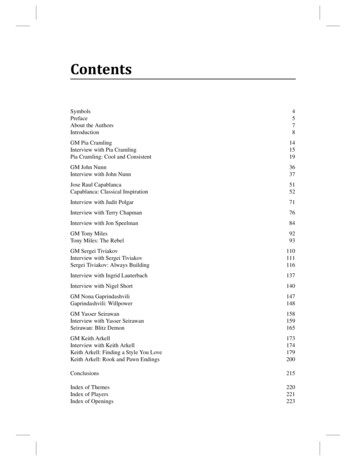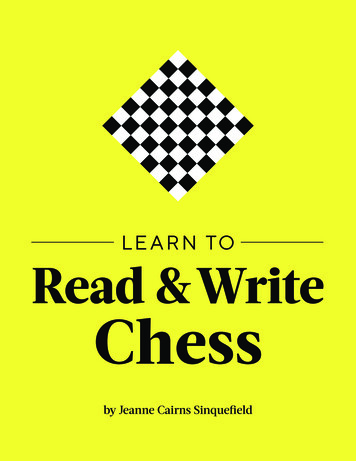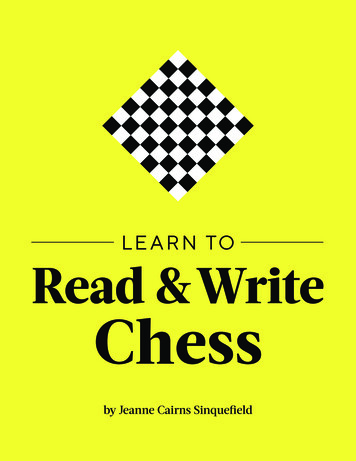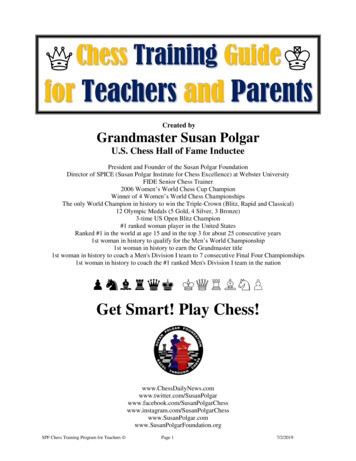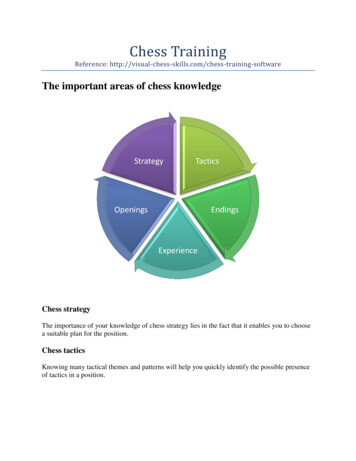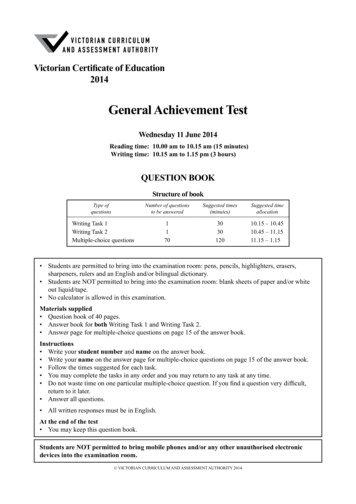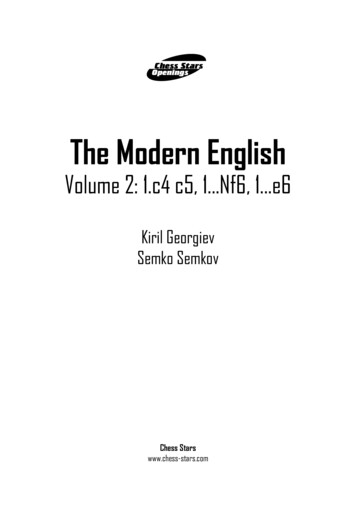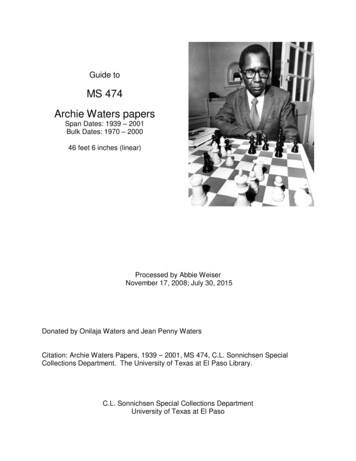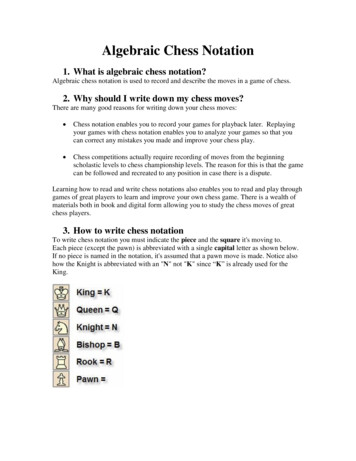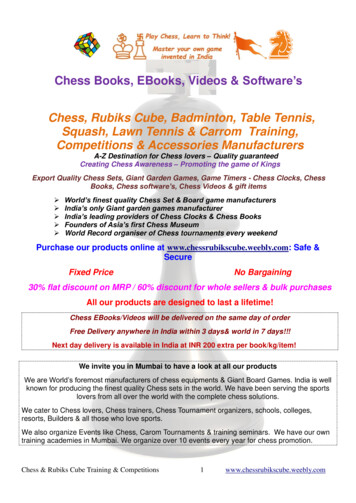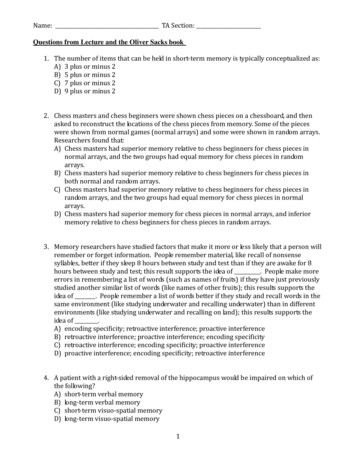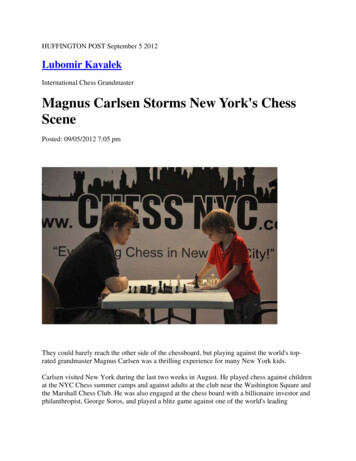
Transcription
HUFFINGTON POST September 5 2012Lubomir KavalekInternational Chess GrandmasterMagnus Carlsen Storms New York's ChessScenePosted: 09/05/2012 7:05 pmThey could barely reach the other side of the chessboard, but playing against the world's toprated grandmaster Magnus Carlsen was a thrilling experience for many New York kids.Carlsen visited New York during the last two weeks in August. He played chess against childrenat the NYC Chess summer camps and against adults at the club near the Washington Square andthe Marshall Chess Club. He was also engaged at the chess board with a billionaire investor andphilanthropist, George Soros, and played a blitz game against one of the world's leading
economists, Kenneth Rogoff. He shot baskets at pick-up games, visited the New York Yankees,and saw friends.Carlsen was teaching children for the first time. "Magnus enjoyed working with them," said hismanager Espen Agdestein. " He hopes to be back next year."Michael Propper, the co-director of the New York City Chess programs, was ecstatic:" The weekreached well beyond traditional chess introduction and promotion. It was motivational,inspirational, informational and, most importantly, tremendous fun.the impact of which will befelt for a very long time. " He added that Magnus can teach, cares and enjoys working withchildern and his visit inspired many chess fans.George Soros is a chess lover and has played the game more or less regularly since he learned itduring the war in 1944. He invited Carlsen and Agdestein to his summer house in the Hamptons.They had a four-hour lunch, with undoubtedly interesting discussions and lots of chess.Eventually, Soros and Carlsen teamed up against Agdestein and Richard Conn, a New Yorklawyer who helped Anatoly Karpov in his bid for FIDE presidency in 2010. The outcome of thegame was never in doubt.
Arctic Securites, Carlsen's main sponsor, hosted a dinner in a fine New York restaurant, Per Se,on August 28. To give the evening a little chess flavor, Carlsen and Rogoff played an exhibitiongame. It was intended to be a five-minute blitz game but the clock was not working properly.They casually continued at a blitz-like pace anyway.Rogoff has been Carlsen's admirer for some time. " Magnus plays at level of tactical brillianceand sublime endgame technique that I could not even imagined, even from people like Petrosian,Tal and Larsen whom I played in the 1976 Interzonal in Biel." Needless to say that Ken drew thegames against the three chess giants. He qualified for Biel by finishing second at the 1975 U.S.championship where I was one of his victims.Rogoff's chess talent was extraordinary. At 15, he played a blindfold simultaneous exhibitionagainst 25 opponents in Rochester, N.Y. At 16, he was one of the top U.S. juniors and hisconsiderable chess skills were publicly recognized by Bobby Fischer. He finished third at the1971 World Junior Championship. In the same year he was a member of the U.S. team at thestudent olympiad in Mayaguez, Puerto Rico, and I was the captain. We played in U.S.championships and met on a few occasions when he lived in Washington, D.C. Rogoff becamegrandmaster in 1978, but after a few years left chess.He turned to economy and became one of the most respected experts. He has been Thomas D.Cabot Professor of Public Policy and Professor of Economics at Harvard University since 1999and for a brief two year period (2001-2003) the Chief Economist and Director of Research at theIMF. His advice is being sought by financial and political leaders throughout the world.For more than 30 years, Rogoff didn't play any chess games, not even casual blitz games. Whatwas he thinking about going against the man who just reached his highest rating of 2843 and sitsat the top of the FIDE rating list as the world's best?
"I miraculously was allowed to escape with a draw," said the only chess grandmaster amongprominent economists, and the best economist among chessplayers. The game tells a differentstory.Blitz games should not be commented, some say, but moves that come to you are often based oninstinct and can reveal a player's character. Greed, courage and fear are magnified. Brilliance isencouraged, but not practical. Carlsen said that Rogoff played a good game. The notes are partlybased on their post-mortem.Rogoff,Kenneth - Carlsen,MagnusBreyer Spanishblitz game - New York , 28.08.20121.e4 e5 2.Nf3 Nc6 3.Bb5 a6 4.Ba4 Nf6 5.0-0 Be7 6.Re1 b5 7.Bb3 0-0 8.c3 d6 9.h3 Nb8The Breyer variation of the Spanish. "The defense is credited to Guyla Breyer, a Hungarianmaster who was among the top ten players in the world in 1918 but who died in 1921 at only age27 of heart attack," writes Larry Kaufman in his absorbing book "The Kaufman Repertoire forBlack and White," published by New In Chess. "To come up with the move 9.Nb8 at the timetook a real genius, as the belief in "development" was very strong since the time of Morphy."However, the world champion William Steinitz and his challenger Mikhail Chigorin chased theirhorses back to the stable, to the square b8, long before Breyer did, perhaps less elegantly.10.d4 Nbd7 11.Nbd2 c5
The immediate strike in the center was popular at the speed events in Astana in July.11.Bb7 12.Bc2 Re8 13.Nf1 Bf8 14.Ng3 c5 is how the Breyer Main line usually unwinds.In the game Polgar-Spassky, played in Budapest 1993, black made a slip 11.Re8? and Juditoverlooked 12.Bxf7 ! Kxf7 13.Ng5 Kg8 14.Ne6 winning.12.Nf1Carlsen provided some clues for black's play in his game against Veselin Topalov in Astana2012: 12.d5 c4 13.Bc2 Qc7 14.Nf1 Nc5 Compared to the Breyer Main line, black saved movesRf8-e8 and Bc8-d7. 15.N3h2 a5 16.a3 Rb8 17.Bd2 Nfd7 18.Ng3 Qd8 19.Nf5 Nb6 20.Nxe7 Qxe7 21.Be3 Nba4 22.Rb1 f5 23.f3 f4 24.Bf2 g5 25.Kf1 Bd7 26.Ke2 b4 27.axb4 axb4 28.Qd2b3 29.Bd1 Nd3 30.Rg1 Bb5 31.Kf1 Ra8 32.g3 Kh8 33.gxf4 gxf4 34.Rg4 Bd7 35.Bh4 Qf736.Be2 Nac5 37.Kg2 h5 38.Rg5 Rg8 39.Bxd3 Nxd3 40.Kh1 Rxg5 41.Bxg5 Bxh3 42.Rg1 Rg843.Qe2 Kh7 44.Bh4 and Topalov resigned. After 44.Rxg1 45.Kxg1 Qa7 46.Kh1 Qa1 andblack wins.12.Re8 13.Ng3 Bf8 14.a4Ivanchuk as black didn't have problems to equalize against Grischuk in Astana 2012 after 14.Bc2cxd4 15.cxd4 exd4 16.Nxd4 d5 17.exd5 Rxe1 18.Qxe1 Bb7 19.Ngf5 Bxd5 20.Be3 Rc8 21.Rd1Qe8 22.Bb1 Be4 23.Bf4 Bxb1 24.Rxb1 Nc5 and the game petered out to a draw.14.Bb7 15.Ng515.Bc2 g6 16.d5 (After 16.b3 d5 is possible.) 16.c4 would be the Bryer Main line.15.c4 16.Bc2
16.d5?!Carlsen goes for a violent clash in the center. "A very enterprising pawn sacrifice giving lots ofcompensation and perfect for crushing a much weaker player," says Rogoff. 16.h6 was playedpreviously. Computers suggest 16.exd4 17.Qxd4 (17.cxd4 b4) 17.Nc5 with a pleasant gamefor black.17.dxe5 Nxe5 18.f4 Nd3 19.Bxd3 cxd3 20.e5 Ne4Computers prefer sharper and more complicated way: 20.h6 21.Nf3 (21.exf6 Qb6 22.Kh2hxg5; 21.Nxf7 Kxf7 22.exf6 Rxe1 23.Qxe1 d4) 21.Ne4 22.Nf5 bxa4 23.Qxd3 a3 24.bxa3 Rc8with excellent play for the pawn.21.N3xe4After 21.Qxd3 Rogoff wasn't sure how to respond to 21.f6 (Black also has 21.Nxg5 22.fxg5bxa4 23.Rxa4 g6 with roughly equal chances.), but 22.N5xe4 dxe4 23.Qxd8 Raxd8 24.axb5 axb525.exf6 gxf6 26.Be3 Rd3 27.Kf2 is in white's favor.21.dxe4
22.Qh5!Magnus missed this queen sortie and now has to scramble. Fortunately, there is a way out.22.Qb6 23.Kh2After 23.Kf1 black can even try 23.h6 (23.Qg6 24.Qxg6 hxg6 25.Nxe4 f6 26.axb5 axb527.Rxa8 Bxa8 28.Nf2 Bd5 29.Bd2) 24.Qxf7 Kh8 25.Nxe4 Rad8 .23.Qg6 24.Qxg6 hxg6 25.Nxe4 f6?!"25.Rad8 would have given a dynamic equality." - Rogoff26.axb5 axb5 27.Rxa8 Rxa8 28.Nf2 fxe5[28.b4 was possible.]
29.Nxd3?!Carlsen suggested 29.fxe5!?, for example 29.b4 30.c4 b3 31.Nxd3 Ba6 32.Nf4 and white isbetter.29.e4 30.Nf2 Ra1 31.Bd2[31.Rd1 Rb1 32.Ng4 b4]31.Ra2[31.Rxe1 32.Bxe1 e3 33.Ng4 Bc5 is equal.]32.Bc1 Ra1 33.Bd2 Ra2 draw agreed.
Friendly analysis after the game.Images by Chess NYC, Arctic Securities, Espen Agdestein and Natasha Lance Rogoff
Rogoff's chess talent was extraordinary. At 15, he played a blindfold simultaneous exhibition against 25 opponents in Rochester, N.Y. At 16, he was one of the top U.S. juniors and his considerable chess skills were publicly recognized by Bobby Fischer. He finished third at the 1971 World Junior Championship.
